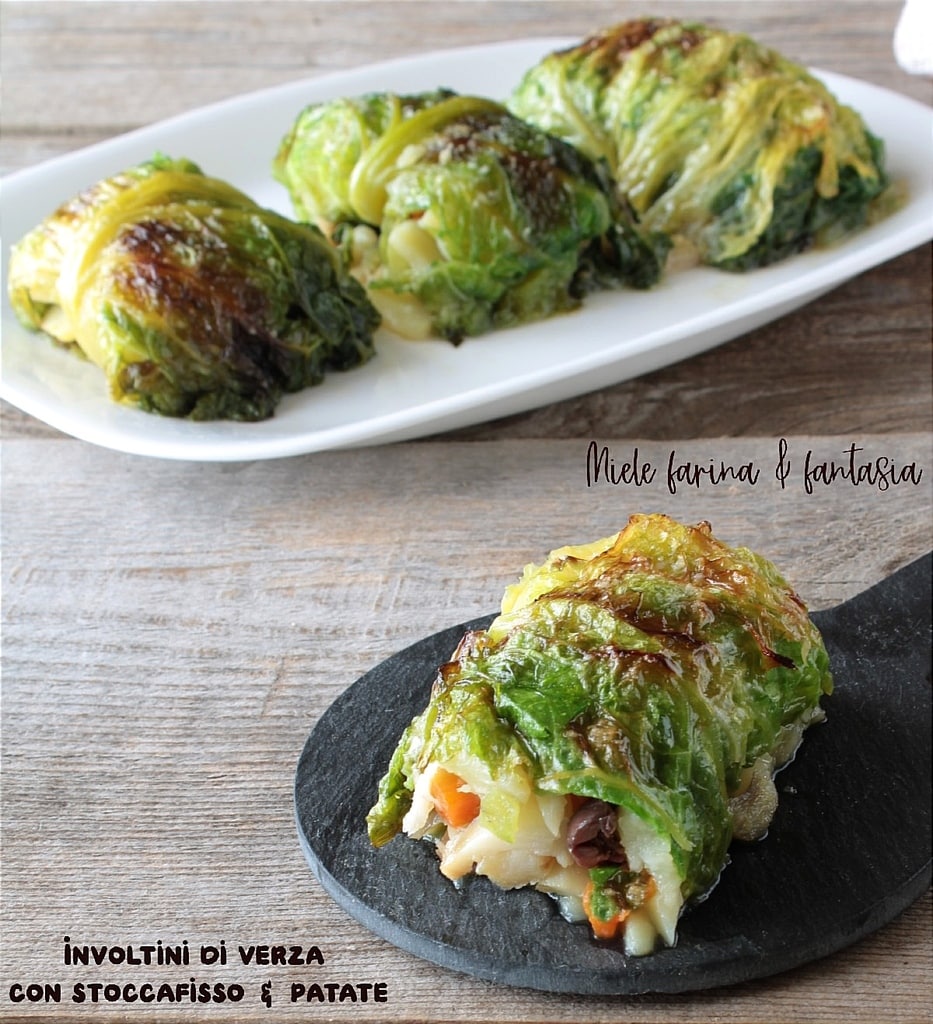Today we talk about cabbage rolls stuffed with stockfish and potatoes, a rich, hearty, and very appetizing fish dish. It is a dish that can also be served on a special occasion or for Sunday lunch. It is also suitable as a recovery recipe, to prepare an alternative dish, different from the usual, using stockfish, or leftover boiled potatoes from a previous recipe. The stockfish and potato rolls can be enjoyed both hot and cold and do not contain eggs, gluten, or dairy.

- Difficulty: Easy
- Cost: Medium
- Preparation time: 1 Hour
- Portions: 6
- Cooking methods: Boiling, Oven
- Cuisine: Italian
- Seasonality: Autumn, Winter, and Spring
Ingredients
- 8 leaves cabbage
- 1.1 lbs stockfish (belly or fillet)
- 10.5 oz already boiled potatoes
- 5.3 oz pitted black olives
- 1 carrot
- 1 stalk celery
- to taste golden onion
- to taste fine salt
- to taste extra virgin olive oil
- to taste coarse salt (for cooking the stockfish)
Steps
To make the cabbage rolls, we must boil the potatoes the day before and keep them in the fridge, so we can slice them thinly without any problems; or we can boil them on the day and then pass them through a potato masher to obtain a puree to spread on the cabbage leaves (I recommend this as it makes rolling the rolls much easier).
The cabbage leaves and the stockfish (the latter will actually undergo “passive” cooking to prevent it from disintegrating) can instead be prepared on the spot when we are ready to make the rolls..
Let’s prepare the cabbage. Let’s take 8 large, intact, and beautiful cabbage leaves. We can use both the outer ones and those a bit more inside. I recommend the outer ones, the greener ones, as they are firmer and more compact and break less. Moreover, I always suggest boiling a few extra cabbage leaves, compared to the number of rolls we intend to prepare, just in case we need to replace any that break or tear.
Let’s put some water in a large pot and bring it to a boil.
Meanwhile, wash and drain the cabbage leaves and prepare a large bowl with cold water.
When the water boils, add the cabbage leaves, all at once, cover and let them boil for one to two minutes (only if they are meaty and firm; otherwise, one minute will be more than enough).
Drain them immediately and plunge them into the cold water for 5 minutes; let them drain in a colander.
Preparation of the stockfish. Speaking of the stockfish, I used the part called the “belly”; you can also use the fillet, called “curuniello”. On this topic, if you are interested, at this link, you will find the history of the stockfish processing technique. Also, remember that stockfish, unlike cod, is completely bland, so adjust with salt, otherwise, you risk having a completely tasteless dish.
At the same time as the water for the cabbage leaves, we put another pot of water to boil with a carrot, a quarter of an onion, and the celery stalk (all properly washed and cleaned of spoiled or inedible parts).
When the water comes to a boil, add a large handful of coarse salt, add the stockfish chunks, cover, let them cook with the lid on for 60 seconds only and then turn off, without touching them for about 15-20 minutes at most. If the stockfish pieces are very thin, about 10-12 minutes at most will be enough for them to cook perfectly passively.
After the time has passed, drain the stockfish (first picture on the left) and remove skin and any bones, “flaking” it as shown in the second picture above.
Cut the carrot and the celery stalk used in the stockfish cooking water into small cubes.
Take a pan suitable for containing the six rolls we will prepare and grease it with some extra virgin olive oil, or line it with parchment paper..
Preparation of the rolls. On a cutting board, place a leaf, with the green part facing us, spread it out well and gently. If the back of the leaf is too thick and prevents rolling it, cut it halfway as you can see in the picture on the right.
1) Sprinkle the inside of the leaf with a pinch of fine salt and then place a first layer of very thin potatoes (or a teaspoon of potato puree.), keeping possibly more towards the center of the leaf
2) Add a few cubes of carrots and celery.
3) Place a few “flakes” of stockfish.
4) Add some pitted black olives.
5) Finish with another pinch of fine salt.
6) Gently roll the cabbage leaf, starting from the wide green part and reaching the back, bringing the two lateral ends of the leaf inward as you roll it, finally placing it in the pan with the closure facing down.
Continue until all the cabbage leaves are stuffed and placed in the pan.. You will likely have leftover ingredients that you can use to prepare a sauce for a first course.
Preheat the oven to 392°F and, at medium height, place the pan with the rolls, on which we will have sprinkled another pinch of fine salt and a drizzle of extra virgin olive oil. Cook them for about 20-25 minutes at most. The cooking times are calibrated on my gas oven, with heat coming only from below in static mode.
The extra idea. We can replace the stockfish with cod; in this case, we will not need to use salt. The process remains the same but requires some advice on cooking; if the cod pieces are at least two fingers thick, the passive cooking times will be about 25 minutes, whereas if they are one finger thick, the passive cooking times are similar to those indicated for stockfish.
Bon appetit

